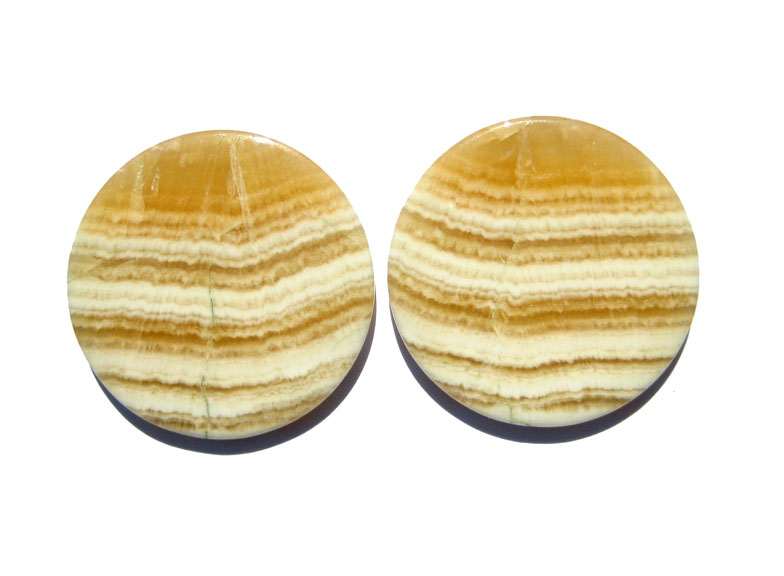|
Agate Cabochons [ Gemstone Cabochons ]
 |
Fine Quality Agate Gemstone Cabochons Wholesaler Supplier Manufacturer Exporter
Most agates occur as nodules in volcanic rocks or ancient lavas where they represent cavities originally produced by the disengagement of volatiles in the molten mass which were then filled, wholly or partially, by siliceous matter deposited in regular layers upon the walls. Such agates, when cut transversely, exhibit a succession of parallel lines, often of extreme tenuity, giving a banded appearance to the section. Such stones are known as banded agate, riband agate and striped agate.
In the formation of an ordinary agate, it is probable that waters containing silica in solution—derived, perhaps, from the decomposition of some of the silicates in the lava itself—percolated through the rock and deposited a siliceous coating on the interior of the vapour-vesicles. Variations in the character of the solution or in the conditions of deposition may cause a corresponding variation in the successive layers, so that bands of chalcedony often alternate with layers of crystalline quartz. Several vapour-vesicles may unite while the rock is still viscous, and thus form a large cavity which may become the home of an agate of exceptional size; thus a Brazilian geode lined with amethyst and weighing 67 tons was exhibited at the Düsseldorf Exhibition of 1902. Perhaps the most comprehensive review of agate chemistry is a recent text by Moxon cited below.
The first deposit on the wall of a cavity, forming the "skin" of the agate, is generally a dark greenish mineral substance, like celadonite, delessite or "green earth", which are rich in iron probably derived from the decomposition of the augite in the enclosing volcanic rock. This green silicate may give rise by alteration to a brown iron oxide (limonite), producing a rusty appearance on the outside of the agate-nodule. The outer surface of an agate, freed from its matrix, is often pitted and rough, apparently in consequence of the removal of the original coating. The first layer spread over the wall of the cavity has been called the "priming", and upon this base zeolitic minerals may be deposited.
Many agates are hollow, since deposition has not proceeded far enough to fill the cavity, and in such cases the last deposit commonly consists of quartz, often amethyst, having the apices of the crystals directed towards the free space so as to form a crystal-lined cavity, or geode.
On the disintegration of the matrix in which the agates are embedded, they are set free. The agates are extremely resistant to weathering and remain as nodules in the soil or are deposited as gravel in streams and shorelines.
A Mexican agate, showing only a single eye, has received the name of cyclops agate. Included matter of a green, golden, red, black or other color or combinations embedded in the chalcedony and disposed in filaments and other forms suggestive of vegetable growth, gives rise to dendritic or moss agate. Dendritic agates have fern like patterns in them formed due to the presence of manganese and iron oxides. Other types of included matter deposited during agate-building include sagenitic growths (radial mineral crystals) and chunks of entrapped detritus (such as sand, ash, or mud). Occasionally agate fills a void left by decomposed vegetative material such as a tree limb or root and is called limb cast agate due to its appearance.
Turritella agate is formed from silicified fossil Elimia tenera (erroneously considered Turritella) shells. E. tenera are spiral marine gastropods having elongated, spiral shells composed of many whorls. Similarly, coral, petrified wood and other organic remains or porous rocks can also become agatized. Agatized coral is often referred to as Petoskey stone or agate.
Greek agate is a name given to pale white to tan colored agate found in Sicily back to 400 B.C. The Greeks used it for making jewelry and beads. Today any agate of this color from Sicily, once an ancient Greek colony, is called Greek agate. Yet the stone had been around centuries before that and was known to both the Sumerians and the Egyptians, who used the gem for decoration and religious ceremony.
Another type of agate is Brazilian agate, which is found as sizable geodes of layered nodules. These occur in brownish tones interlayered with white and gray. Quartz forms within these nodules, creating a striking specimen when cut opposite the layered growth axis. It is often dyed in various colors for ornamental purposes.
Certain stones, when examined in thin sections by transmitted light, show a diffraction spectrum due to the extreme delicacy of the successive bands, whence they are termed rainbow agates. Often agate coexists with layers or masses of opal, jasper or crystalline quartz due to ambient variations during the formation process.
Other forms of agate include Lake Superior agate, carnelian agate (usually exhibiting reddish hues), Botswana agate, Ellensburg blue agate, blue lace agate, plume agates, tube agate (with visible flow channels), fortification agate (which exhibit little or no layered structure), fire agate (which seems to glow internally like an opal) and Mexican crazy-lace agate (which exhibits an often brightly colored, complex banded pattern) also called Rodeo Agate and Rosetta Stone depending on who owned the mine at the time.
|
|